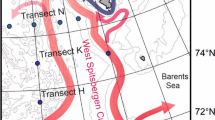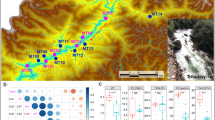Abstract—
Bacterial diversity in attached communities of the anoxic part of the Solodovka wetland (Samara region, Russia), which feeds on cold karst springs with a high (>3 mM) sulfide content was studied using high-throughput sequencing of the variable regions V3−V4 of 16S rRNA gene. The sequences were grouped into 370 operational taxonomic units (OTUs); the OTU number per sample varied within a broad range, from 52 to 277. Taxonomic diversity in the samples depended on mat type, temperature, and sulfide concentration. The highest diversity was found in typical soft cyanobacterial mats; bacterial diversity in hard microbialites was much lower. Phototrophic bacteria formed the basis of all studied communities. In the typical mats, cyanobacteria prevailed, accompanied by phototrophic Chloroflexales, the latter being responsible for 7−13% of the total number of sequences. Hard microbialites and the mat developing at the highest sulfide concentration were characterized by low representation of these taxa and a high proportion of phototrophic Proteobacteria and Chlorobiaceae. Organisms of the sulfur cycle, Desulfobacterota and Campylobacterota, predominated in the chemotrophic part of the communities. While the organisms with fermentative metabolism and facultative chemolithotrophs were represented by a large number of OTUs, they were minor in abundance, and the sequences of the phyla Actinobacteria and Acidobacteria, which are usually widespread in oxic aquatic ecosystems have not been found. In general, the chemotrophic part of the studied communities strongly resembled the attached communities from cave streams and communities of various underground aquifers. Their phototrophic component was formed relatively independently of the chemotrophic one with the participation of the surrounding surface microbiota. The sequences most similar to some of the most abundant OTUs in the Solodovka wetland originated from the chemocline of stratified lakes, including meromictic ones.





Similar content being viewed by others
REFERENCES
Bolger, A.M., Lohse, M., and Usadel, B., Trimmomatic: a flexible trimmer for Illumina sequence data, Bioinformatics, 2014, vol. 30, no. 15, pp. 2114–2120.
Brock, T.D., Vertical zonation in hot spring algal mats, Phycologia, 1969, vol. 8, pp. 201–205.
Chaudhary, A., Haack, S.K., Duris, J.W., and Marsh, T.L., Bacterial and archaeal phylogenetic diversity of a cold sulfur-rich spring on the shoreline of Lake Erie, Michigan, A-ppl. Environ. Microbiol., 2009, vol. 75, pp. 5025–5036.
Dedkov, A.P., Geological and geomorphological conditions of development of brackish karst lakes in Mid-Volga region, in Unikal’nye ekosistemy solonovatovodnykh karstovykh ozer Srednego Povolzh’ya (Unique Ecosystems of Brackish Karst Lakes in Middle Volga Region), Alimov, A.F. and Mingazova, N.M., Eds., Kazan: Kaz. Gos. Univ., 2001, pp. 9–17.
Edgar, R.C., UCHIME2: improved chimera prediction for amplicon sequencing, BioRxiv, 2016, art. 074252. https://doi.org/10.1101/074252
Edgar, R., UPARSE: highly accurate OTU sequences from microbial amplicon reads, Nat. Methods, 2013, vol. 10, pp. 996–998. https://doi.org/10.1038/nmeth.2604
Elshahed, M.S., Senko, J.M., Najar, F.Z., Kenton, S.M., Roe, B.A., Dewers, T.A., Spear, J.R., and Krumhoz, L.R., Bacterial diversity and sulfur cycling in a mesophilic sulfide-rich spring, Appl. Environ. Microbiol., 2003, vol. 69, pp. 5609–5621.
Engel, A.S., Porter, M.L., Stern, L.A., Quinlan, S., and Bennett, P.C., Bacterial diversity and ecosystem function of filamentous microbial mats from aphotic (cave) sulfidic springs dominated by chemolithoautotrophic “Epsilonproteobacteria,” FEMS Microbiol. Ecol., 2004, vol. 51, pp. 31–53.
Farmer J., Grazing and bioturbation in modem microbial mats, in The Proterozoic Biosphere, Schopf, J.W. and Klein, C., Eds., New York: Cambridge Univ. Press, 1992, pp. 295–297.
Gorbunov, M.Yu., Water hydrochemical composition and stratification in the flood-plain Lake Takhtarka, Vestn. VGU, Ser: Geogr. Geoecol., 2019, no. 1, pp. 92–100.
Hallbeck, L. and Pedersen, K., Characterization of microbial processes in deep aquifers of the Fennoscandian Shield, Appl. Geochem., 2008, vol. 23, pp. 1796–1819.
Hamilton, T.L., Jones, D.S., Schaperdoth, I., and Macalady, J.L., Metagenomic insights into S0 precipitation in a terrestrial subsurface lithoautotrophic ecosystem, Front. Microbiol., 2015, vol. 5, art. 756. https://doi.org/10.3389/fmicb.2014.00756
Headd, B. and Engel, A.S., Biogeographic congruency among bacterial communities from terrestrial sulfidic springs, Front. Microbiol., 2014, vol. 5, art. 473. https://doi.org/10.3389/fmicb.2014.00473
Hickman-Lewis, K., Cavalazzi, B., Foucher, F., and Westall, F., Most ancient evidence for life in the Barberton greenstone belt: microbial mats and biofabrics of the ∼3.47 Ga Middle Marker horizon, Precambrian Res., 2018, vol. 312, pp. 45–67.
Javor, B.J. and Castenholz, R.W., Laminated microbial mats, Laguna Guerrero Negro, Mexico, Geomicrobiol. J., 1981, vol. 2, pp. 237–273.
Klatt, J.M., Gomez-Saez, G.V., Meyer, S., Ristova, P.P., Yilmaz, P., Granitsiotis, M.S., Macalady, J.L., Gaute Lavik, G., Polerecky, L., and Bühring, S.I., Versatile cyanobacteria control the timing and extent of sulfide production in a Proterozoic analog microbial mat, ISME J., 2020, vol. 14, pp. 3024–3037.
Kumar, S., Stecher, G., Li, M., Knyaz, C., and Tamura, K., MEGA X: Molecular Evolutionary Genetics Analysis across computing platforms, Mol. Biol. Evol., 2018, vol. 35, pp. 1547–1549.
Machel, H.G., Bacterial and thermochemical sulfate reduction in diagenetic settings – old and new insights, Sediment. Geol., 2001, vol. 140, pp. 143–175.
Mendes Monteiro, J., Vogwill, R., Bischoff, K., and Gleeson, D.B., Comparative metagenomics of microbial mats from hypersaline lakes at Rottnest Island (WA, Australia), advancing our understanding of the effect of mat community and functional genes on microbialite accretion, Limnol. Oceanogr., 2020, vol. 65(S1), pp. S293–S309.
Orleanskiy, V.K., Yeroshchev-Shak, V.A., Karpov, G.A., and Inkova, T.A., Bedded bacterial-algal formation (mats) in the Kamchatka thermal fields, Int. Geol. Rev., 1984, vol. 26, pp. 298–302.
Pierson, B.K. and Castenholz, R.W., A phototrophic gliding filamentous bacterium of hot springs, Chloroflexus au-rantiacus, gen. and sp. nov., Arch. Microbiol., 1974, vol. 100, pp. 5–24. https://doi.org/10.1007/BF00446302
Prieto-Barajas, C.M., Valencia-Cantero, E., and Santoyo, G., Microbial mat ecosystems: structure types, functional diversity, and biotechnological application, Electron. J. Biotechnol., 2018, vol. 31, pp. 48–56.
Protisty i bakterii ozer Samarskoi oblasti (Protists and Bacteria of Samara Oblast Lakes), Zharikov, V.V., Ed., Tolyatti: Kassandra, 2009.
Pruesse, E., Peplies, J., and Glöckner, F.O., SINA: accurate high-throughput multiple sequence alignment of ribosomal RNA genes, Bioinformatics, 2012, vol. 28, pp. 1823–1829.
Quast, C., Pruesse, E., Yilmaz, P., Gerken, J., Schweer, T., Yarza, P., Peplies, J., and Glöckner, F.O., The SILVA ribosomal RNA gene database project: improved data processing and web-based tools, Nucl. Acids Res., 2013, vol. 41(D1), pp. D590–D596.
Sahl, J.W., Gary, M.O., Harris, J.K., and Spear, J.R., A comparative molecular analysis of water-filled limestone sinkholes in north-eastern Mexico, Environ. Microbiol., 2011, vol. 13, pp. 226–240.
Savvichev, A.S., Kadnikov, V.V., Rusanov, I.I., Beletsky, A.V., Krasnova, E.D., Voronov, D.A., Kallistova, A.Yu., Veslopolova, E.F., Zakharova, E.E., Kokryatskaya, N.M., Losyuk, G.N., Demidenko, N.A., Belyaev, N.A., Sigalevich, P.A., Mardanov, A.V., et al., Microbial processes and microbial communities in the water column of the polar meromictic Lake Bol’shie Khruslomeny at the White Sea coast, Front. Microbiol., 2020, vol. 11, art. 1945.
Schiff, S.L., Tsuji, J.M., Wu, L., Venkiteswaran, J.J., Molot, L.A., Elgood, R.J., Paterson, M.J., and Neufeld, J.D., Millions of boreal shield lakes can be used to probe Archaean Ocean biogeochemistry, Sci. Rep., 2017, vol. 7, pp. 1–11.
Selivanova, E.A., Poshvina, D.V., Khlopko, Y.A., Plotnikov, A.O., and Gogoleva, N.E., Diversity of prokaryotes in planktonic communities of saline Sol-Iletsk lakes (Orenburg oblast, Russia), Microbiology (Moscow), 2018, vol. 87, pp. 569–582.
Semikhatov, M.A., Gebelein, C.D., Cloud, P., Awramik, S.M., and Benmore, W.C., Stromatolite morphogenesis—progress and problems, Can. J. Earth Sci., 1979, vol. 16, pp. 992–1015.
Waite, D.W., Chuvochina, M., Pelikan, C., Parks, D.H., Yilmaz, P., Wagner, M., Loy, A., Naganuma, T., Nakai, R., Whitman, W.B., and Hahn, M.W., Proposal to reclassify the proteobacterial classes Deltaproteobacteria and Oligoflexia, and the phylum Thermodesulfobacteria into four phyla reflecting major functional capabilities, Int. J. Syst. Evol. Microbiol., 2020, vol. 70, pp. 5972–6016.
Whitman, W.B., Coleman, D.C., and Wiebe, W.J., Prokaryotes: the unseen majority, Proc. Natl. Acad. Sci. U. S.A., 1998, vol. 95, pp. 6578–6583.
Wingett, S.W. and Andrews, S., FastQ Screen: a tool for multi-genome mapping and quality control, F1000Research, 2018, vol. 7. https://doi.org/10.12688/f1000research.15931.2
Zavarzin, G.A., Lektsii po prirodovedcheskoi mikrobiologii (Lectures in Natural Science Microbiology), Moscow: Nauka, 2004.
Zerkle, A.L., Jones, D.S., Farquhar, J., and Macalady, J.L., Sulfur isotope values in the sulfidic Frasassi cave system, central Italy: a case study of a chemolithotrophic S-based ecosystem, Geochim. Cosmochim. Acta, 2016, vol. 173, pp. 373–386.
Zhang, J., Kobert, K., Flouri, F., and Stamatakis, A., PEAR: a fast and accurate Illumina Paired-End reAd mergeR, Bioinformatics, 2014, vol. 30, pp. 614–620. https://doi.org/10.1093/bio-informatics/btt593
ACKNOWLEDGMENTS
DNA sequencing was carried out using the Microbial Persistence Joint Use Center, Institute for Cellular and Intracellular Symbiosis, Ural Branch, Russian Academy of Sciences. The authors are grateful to A.O. Plotnikov for recommendations on sample fixation and processing and for participation in bioinformatical treatment of the data, and to the unknown reviewer for the comments which resulted in a significant improvement of the manuscript.
Funding
The work was carried out within the framework of the Program for Basic Research of the State Academies of Sciences for 2013–2020 (project no. AAAA-A17-117112040040-3).
Author information
Authors and Affiliations
Corresponding author
Ethics declarations
The authors declare that they have no conflict of interest. This article does not contain any studies involving animals or human participants performed by any of the authors.
Additional information
Translated by P. Sigalevich
Rights and permissions
About this article
Cite this article
Gorbunov, M.Y., Khlopko, Y.A., Kataev, V.Y. et al. Bacterial Diversity in Attached Communities of a Cold High-Sulfide Water Body in European Russia. Microbiology 91, 77–90 (2022). https://doi.org/10.1134/S0026261722010040
Received:
Revised:
Accepted:
Published:
Issue Date:
DOI: https://doi.org/10.1134/S0026261722010040




